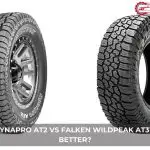When we think about versatile pickup trucks that offer endless customization potential, the Ford Ranger stands out as a top choice for modification enthusiasts. This mid-size pickup has captured our attention with its robust platform that welcomes everything from simple aesthetic upgrades to extreme off-road transformations.
We’ve witnessed the Ford Ranger evolve into something truly special in the hands of creative builders and weekend warriors alike. Whether you’re dreaming of a lifted beast that conquers mountain trails or a lowered street machine that turns heads at car shows, the Ranger’s adaptable design makes nearly anything possible.
The beauty of modifying a Ford Ranger lies in its perfect balance of affordability and capability. We’ll explore how this truck has become a canvas for personal expression while maintaining the reliability and performance that Ford built into its DNA.
Essential Engine Modifications for Ford Ranger Performance
Engine modifications unlock the Ford Ranger’s hidden power potential while maintaining daily drivability. These upgrades work synergistically to transform your truck’s performance characteristics.
Cold Air Intake Systems
Cold air intakes represent the most accessible performance upgrade for Ford Rangers. We recommend high-flow systems that relocate the air filter outside the engine bay to draw cooler, denser air into the combustion chambers.
Top cold air intake benefits include:
- Increased horsepower gains of 5-15 HP
- Improved throttle response during acceleration
- Enhanced engine sound with aggressive intake note
- Better fuel economy under highway driving conditions
Popular intake brands like K&N, Spectre, and AEM offer drop-in answers that require basic hand tools for installation. These systems typically cost between $150-400 and provide noticeable performance improvements within the first drive cycle.
Performance Exhaust Upgrades
Performance exhausts dramatically improve both power output and sound quality in modified Ford Rangers. We’ve found that cat-back exhaust systems deliver the best balance of performance gains and installation simplicity.
Key exhaust modification advantages:
- Power increases of 10-20 HP at the wheels
- Reduced exhaust backpressure for better engine breathing
- Weight reduction of 15-25 pounds compared to stock systems
- Customizable sound profiles from subtle to aggressive
Borla, Magnaflow, and Flowmaster manufacture exceptional systems ranging from $400-800. Headers provide additional power gains of 8-12 HP but require more extensive installation work and professional tuning adjustments.
ECU Tuning and Chip Modifications
ECU tuning represents the most important performance modification for Ford Ranger engines. We use custom tune files that optimize fuel maps, ignition timing, and throttle response parameters for maximum efficiency.
Professional tuning delivers these results:
- Horsepower gains of 20-40 HP depending on engine configuration
- Torque increases of 30-50 lb-ft across the powerband
- Improved drivability with smoother power delivery
- Optimized fuel economy during cruise conditions
Reputable tuning companies like SCT, Diablosport, and Edge offer handheld programmers starting at $300. Custom dyno tuning sessions cost $400-600 but provide personalized calibrations that maximize your exact modifications and driving requirements.
Suspension and Lift Kit Upgrades for Off-Road Capability
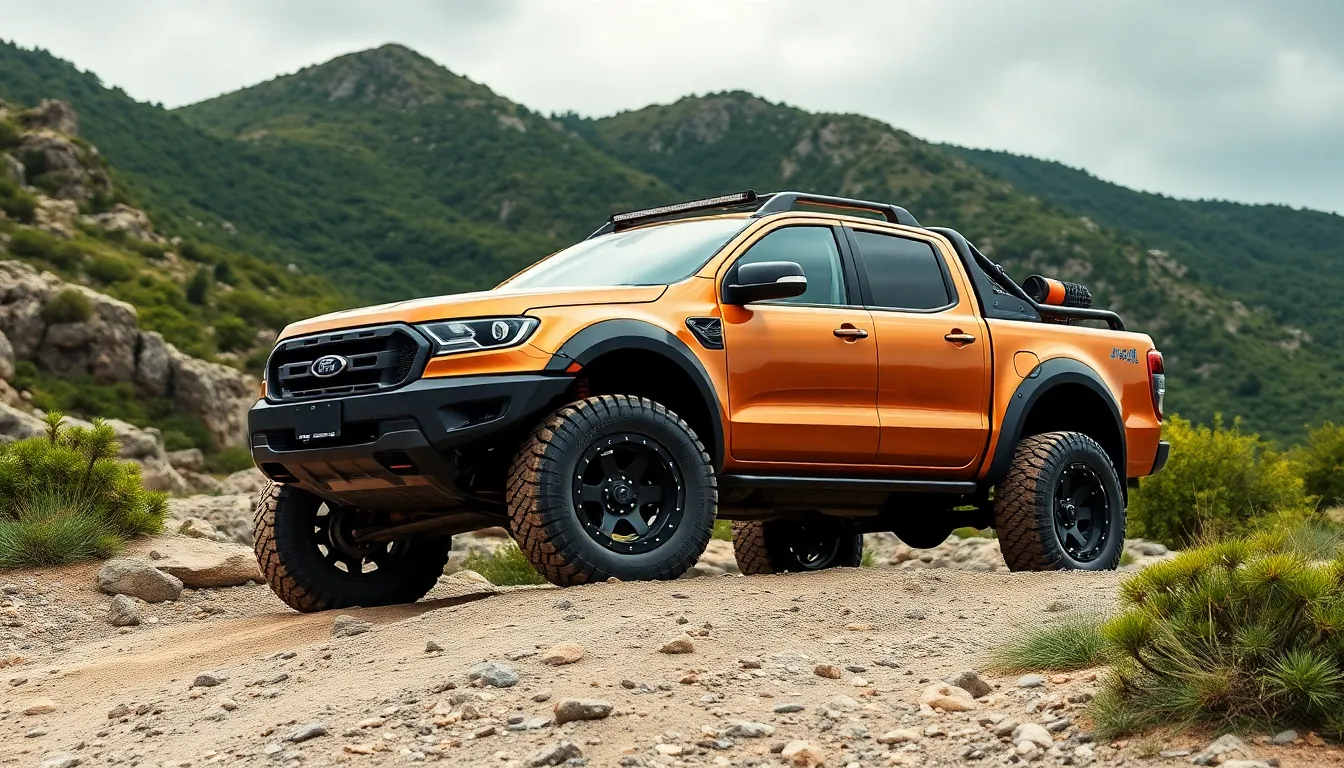
Building on your performance upgrades, suspension modifications transform your Ford Ranger into a capable off-road machine. These changes dramatically improve ground clearance, articulation, and handling on challenging terrain.
Body Lift Kits vs Suspension Lifts
Body lift kits provide a cost-effective solution for gaining clearance without altering your Ranger’s suspension geometry. These kits typically raise the truck body 2-3 inches above the frame using spacers and longer bolts, costing between $300-600 for a complete installation. We recommend body lifts for budget-conscious builders who primarily need tire clearance for larger wheels without affecting ride quality.
Suspension lifts offer superior performance benefits by raising the entire front and rear suspension components. These comprehensive systems provide 2-6 inches of lift height and cost $800-2500 depending on quality and complexity. Suspension modifications improve approach angles, departure angles, and breakover angles while maintaining proper wheel alignment geometry.
Performance differences become apparent during serious off-road use where suspension lifts excel in articulation and stability. Body lifts maintain factory ride characteristics but limit suspension travel compared to full suspension systems. We’ve found that suspension lifts better accommodate larger tire sizes like 33-35 inch treads without rubbing issues.
Shock Absorber and Strut Replacements
Quality shock absorbers transform your lifted Ranger’s handling characteristics both on and off-road. Bilstein 5100 series shocks provide excellent value at $400-600 per set with adjustable height settings and improved damping control. These units offer 0-2.25 inches of front lift while maintaining street manners for daily driving applications.
Fox Racing shocks represent the premium tier with prices ranging $800-1200 per set for 2.0 Performance series units. Advanced features include position-sensitive damping, remote reservoirs, and rebuildable construction that handles extreme off-road punishment. We’ve tested these extensively and found important improvements in high-speed desert running and rock crawling scenarios.
KYB MonoMax shocks offer a middle-ground option at $300-450 per set with monotube construction and increased fluid capacity. These units work particularly well with moderate lift heights of 2-4 inches and provide better heat dissipation than twin-tube designs. Performance gains include reduced body roll, improved braking stability, and enhanced load-carrying capacity.
Leaf Spring and Coil Spring Modifications
Leaf spring upgrades address the Ford Ranger’s rear suspension limitations while improving load capacity and ride quality. Add-a-leaf kits cost $150-250 and provide 1-2 inches of lift with increased spring rate for heavy hauling duties. These modifications work well for utility-focused builds that require additional payload capacity without full spring replacement.
Complete leaf spring replacement offers more comprehensive benefits with custom spring rates and lift heights from 2-6 inches. Quality aftermarket springs from manufacturers like Deaver cost $600-900 but provide superior articulation and durability compared to factory units. We recommend progressive rate springs that offer comfort during light loads and stiffness under heavy weight conditions.
Coil spring conversions represent the ultimate rear suspension upgrade for serious off-road applications. These systems replace leaf springs entirely with coil-over shock units and four-link suspension geometry costing $2000-3500 for complete kits. Benefits include increased wheel travel, improved articulation, and adjustable ride height that transforms your Ranger’s off-road capability dramatically.
Exterior Styling Modifications That Transform Your Ford Ranger

Moving beyond performance and suspension upgrades, we’ll explore how exterior modifications can dramatically change your Ranger’s appearance while adding functional benefits. These visual enhancements complement the mechanical improvements we’ve discussed, creating a cohesive build that performs as good as it looks.
Custom Front and Rear Bumpers
Heavy-duty steel bumpers provide the most protection for serious off-road adventures, typically weighing 100-150 pounds but offering maximum impact resistance. Companies like Road Armor and Fab Fours manufacture these robust options with integrated winch mounts, D-ring recovery points, and approach angle improvements of 10-15 degrees.
Aluminum bumpers deliver a lighter alternative at 60-80 pounds while maintaining excellent durability and corrosion resistance. Brands such as ADD OffRoad and Demello OffRoad specialize in these weight-conscious designs that won’t affect your suspension’s performance or fuel economy significantly.
Modular bumper systems allow customization through interchangeable components like skid plates, light pods, and recovery gear mounts. These adaptable designs let you configure protection levels based on your exact driving needs, from daily commuting to extreme rock crawling.
LED Light Bar and Auxiliary Lighting
Straight LED light bars mounted above the windshield provide the widest beam pattern, with 50-inch bars delivering 25,000-30,000 lumens of output for maximum trail visibility. We recommend positioning these bars to avoid glare reflection off your hood while maintaining optimal light distribution.
Curved light bars follow your Ranger’s roofline more naturally, reducing wind noise at highway speeds while providing similar illumination performance. These aerodynamic designs integrate seamlessly with most roof rack systems and maintain your truck’s sleek appearance.
Auxiliary pod lights offer targeted illumination for exact tasks like cornering, backup assistance, or work site lighting. Mounting options include A-pillar brackets, bumper integration, or bed rail systems that provide 3,000-5,000 lumens per pod without overwhelming other drivers.
Fog light upgrades replace factory halogen units with LED alternatives that consume 75% less power while producing three times more light output. These direct replacements maintain your original wiring harness compatibility and DOT compliance for street legal operation.
Fender Flares and Side Steps
Bolt-on fender flares accommodate larger tire sizes up to 35 inches while providing legal tire coverage in most states. Bushwacker and EGR manufacture textured options that resist scratches and UV damage, extending 2-4 inches beyond stock fender lines.
Rivet-style flares create an aggressive appearance that complements lifted Rangers with oversized tires and aftermarket wheels. These wider extensions require professional installation but offer maximum tire clearance for serious off-road builds.
Rock sliders protect your Ranger’s rocker panels from trail damage while providing a solid step surface that supports 400+ pounds. These tube-style protectors mount directly to your frame rails, distributing impact loads across multiple mounting points.
Running boards offer easier cab access for daily driving while maintaining ground clearance for light off-road use. Aluminum and steel options provide different weight and durability characteristics, with retractable models available for maximum clearance when needed.
Interior Comfort and Technology Upgrades
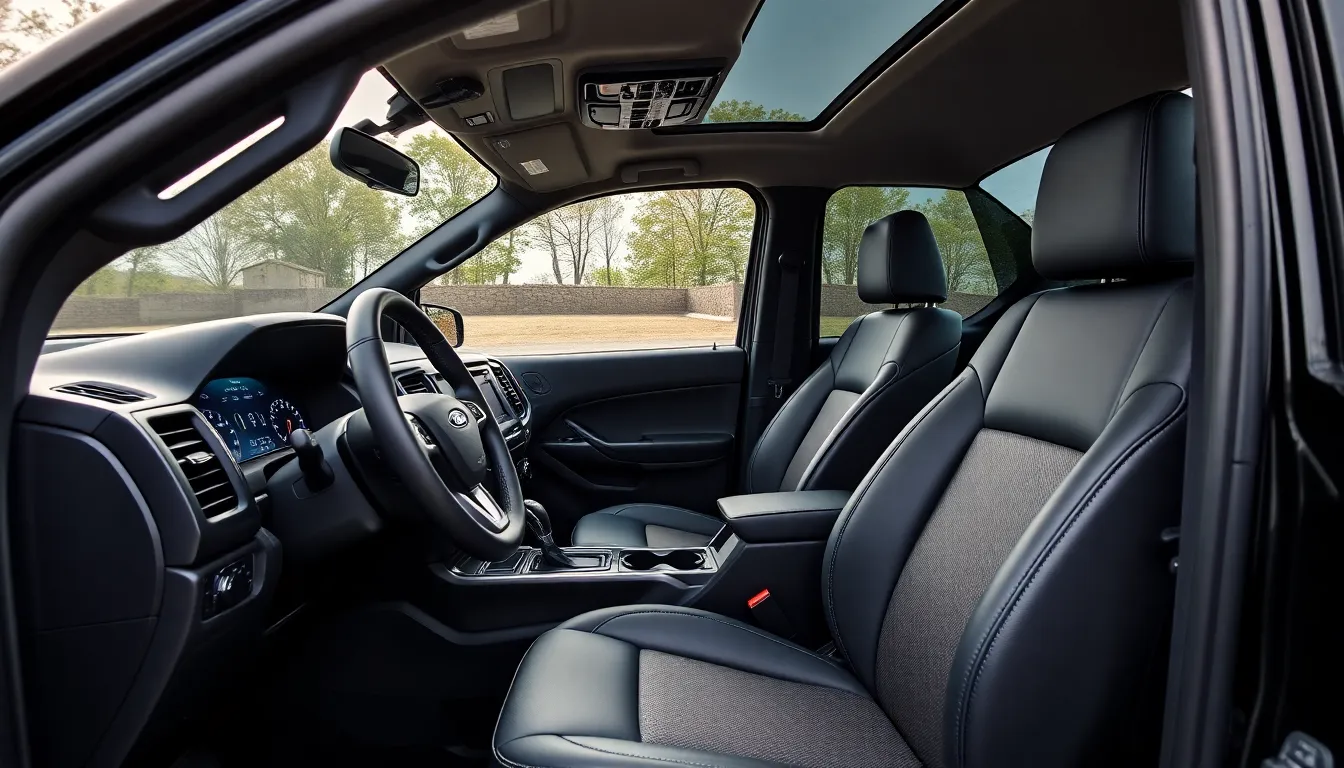
While exterior modifications grab attention and performance upgrades deliver thrills, interior enhancements create the daily comfort and convenience that make every Ford Ranger drive enjoyable.
Custom Seat Covers and Upholstery
Neoprene seat covers provide the ultimate protection for active Ford Ranger owners who frequently encounter water, mud, or heavy use. We’ve found that brands like Wet Okole and Coverking offer custom-fit neoprene options that resist stains and clean easily with simple soap and water. These covers typically cost $200-400 per set and maintain their appearance even after years of abuse.
Leather upholstery upgrades transform the Ranger’s cabin into a premium environment that rivals luxury vehicles. Companies like Katzkin specialize in custom leather installations that perfectly match factory seating contours while adding heating elements and accent stitching. Installation costs range from $1,500-2,500 depending on leather grade and customization options.
Heavy duty canvas covers excel in extreme work environments where durability trumps luxury. Carhartt and MSA offer reinforced canvas seat covers with multiple layers of protection that withstand welding sparks, sharp tools, and constant wear. We recommend these for contractors and tradespeople who use their Rangers as mobile workstations.
Aftermarket Infotainment Systems
Android Auto and CarPlay integration brings smartphone connectivity to older Ford Rangers that lack factory support. Pioneer, Kenwood, and Alpine manufacture head units specifically designed for Ranger dash openings, with installation kits that maintain factory appearance. These systems typically cost $300-800 and provide navigation, streaming music, and hands-free calling.
Touchscreen display upgrades replace factory radios with larger, more responsive screens that enhance usability and modern appeal. We’ve installed 8-inch and 9-inch displays from brands like Boss Audio and Jensen that offer DVD playback, Bluetooth connectivity, and backup camera integration. Installation requires dash modification but results in dramatically improved functionality.
Premium audio system installations transform the Ranger’s sound quality through component speakers, amplifiers, and subwoofers. JL Audio and Rockford Fosgate offer Ranger-exact speaker packages that fit factory locations without cutting or modification. Adding a powered subwoofer under the rear seat creates full-range sound that rivals luxury car audio systems.
Dashboard and Gauge Cluster Modifications
Auxiliary gauge pods provide critical engine monitoring for modified Ford Rangers with performance upgrades. Auto Meter and VDO manufacture triple gauge pods that mount above the factory dash, displaying boost pressure, exhaust gas temperature, and transmission temperature. We position these gauges within easy viewing range while maintaining factory aesthetics.
Digital gauge cluster conversions replace analog speedometers and tachometers with customizable LCD displays that show multiple parameters simultaneously. Dakota Digital offers direct-fit clusters for various Ranger model years that display engine vitals, trip information, and diagnostic codes. Installation preserves factory wiring while adding modern functionality.
Custom dashboard trim personalizes the Ranger’s interior through carbon fiber, wood grain, or brushed aluminum accents that replace factory plastic panels. Companies like Dash Designs create custom-molded pieces that snap into place without adhesives or permanent modification. These upgrades cost $100-300 but dramatically change the cabin’s visual appeal and perceived quality.
Wheel and Tire Combinations for Enhanced Performance
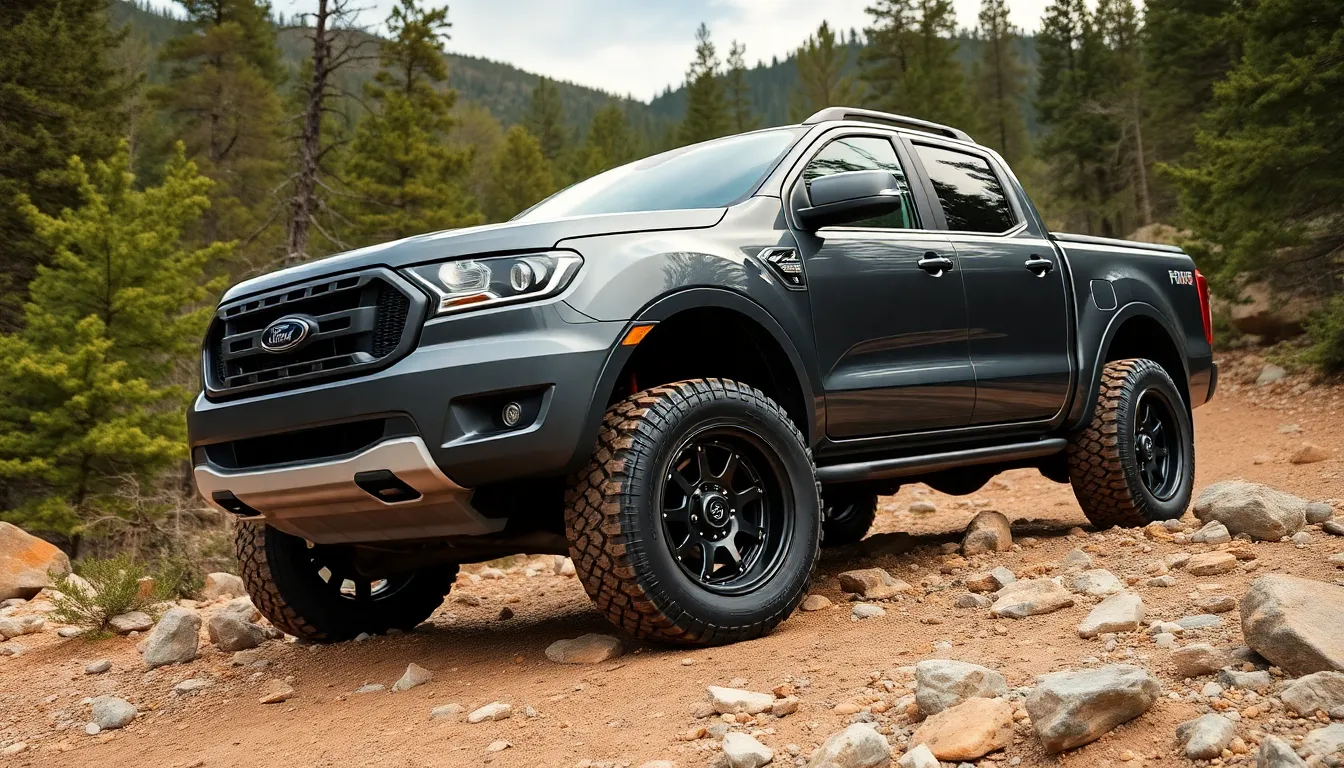
Selecting the right wheel and tire combination transforms your Ford Ranger’s performance characteristics while completing the visual modifications we’ve discussed. These choices directly impact traction, handling, and off-road capability more than any other single modification.
All-Terrain vs Mud-Terrain Tire Options
All-terrain tires offer the most versatile performance for modified Rangers that see mixed driving conditions. Popular choices like the BFGoodrich All-Terrain T/A KO2 provide excellent on-road comfort with impressive off-road traction in sizes ranging from 31″ to 35″ diameter. These tires maintain highway manners while delivering reliable grip on gravel, dirt, and light mud terrain.
Mud-terrain tires excel in extreme off-road conditions but sacrifice some on-road refinement for maximum traction. Options like the Nitto Mud Grappler or Toyo Open Country M/T feature aggressive tread patterns with deep lugs that clear debris effectively. We recommend mud-terrain tires for Rangers primarily used for serious trail work, as they generate more road noise and wear faster on pavement.
Tire sizing typically ranges from 265/75R16 (31″ diameter) on stock Rangers to 315/75R16 (35″ diameter) on heavily modified builds. Larger sizes require corresponding suspension modifications to prevent rubbing and maintain proper geometry.
Rim Size and Offset Considerations
Rim diameter selection balances sidewall protection with handling characteristics on your modified Ranger. Stock 15″ and 16″ wheels accommodate larger tire sidewalls that absorb impacts better during off-road use. Upgrading to 17″ or 18″ wheels reduces sidewall height but improves steering response and brake clearance for performance applications.
Wheel offset significantly affects your Ranger’s track width and suspension geometry. Stock offset ranges from +44mm to +50mm depending on the year and trim level. Reducing offset to +25mm or +30mm pushes wheels outward, improving stability and creating a more aggressive stance without requiring spacers.
Backspacing measurements work inversely to offset, with stock Rangers typically running 6.5″ to 7″ of backspacing. Reducing backspacing to 4.5″ or 5″ achieves similar results to lower offset wheels while ensuring proper clearance from suspension components.
Wheel Spacers and Hub Modifications
Wheel spacers provide an affordable way to achieve wider track width without purchasing new wheels. We recommend 1.25″ to 2″ spacers for most Ranger applications, which push wheels outward enough to clear larger tires while maintaining safe engagement with wheel studs.
Hub-centric spacers eliminate vibrations by centering properly on the vehicle’s hub, unlike universal spacers that rely solely on lug nuts for centering. Quality brands like Spidertrax and Bora offer application-exact spacers with proper hub bore dimensions for Rangers.
Stud length becomes critical when running spacers thicker than 1″. Longer wheel studs or hub-mounted spacers with integrated studs ensure adequate thread engagement for safety. Most installations require at least 6-8 full threads of engagement beyond the spacer thickness.
Extended wheel studs also benefit Rangers running aftermarket wheels with different mounting requirements. ARP wheel studs provide superior strength over factory units and accommodate various spacer and wheel combinations without compromising safety.
Bed Modifications for Utility and Style
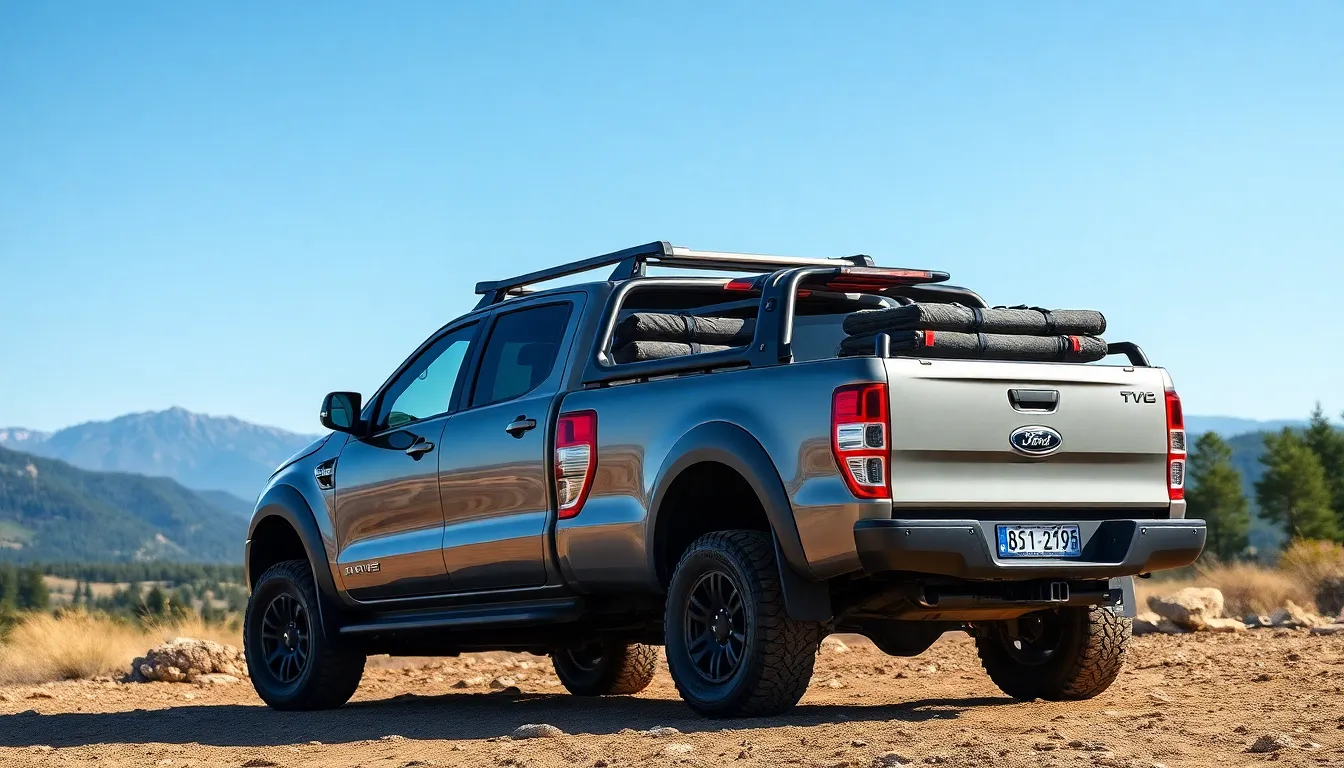
Transforming your Ford Ranger’s bed functionality completes the comprehensive modification journey we’ve explored. These upgrades enhance both practical utility and visual appeal while protecting your investment.
Tonneau Covers and Bed Liners
Tonneau covers provide instant security and weather protection for your modified Ranger’s cargo area. Hard folding covers like the BAKFlip MX4 offer 400-pound weight capacity and complete weather sealing, while soft roll-up options from Tyger Auto provide budget-friendly protection starting around $200. We recommend aluminum hard covers for maximum durability and theft deterrence.
Drop-in bed liners shield your truck bed from scratches, dents, and chemical damage during heavy use. LINE-X spray-on coatings create a permanent, textured surface that prevents cargo movement and resists UV damage for up to 10 years. DualLiner systems combine rubber mats with plastic sidewall protection, offering removable convenience for thorough cleaning. Rhino Linings provide similar protection with a softer texture that’s gentler on equipment and tools.
Color matching options allow bed liners to complement your Ranger’s exterior modifications seamlessly. Most spray-on applications can match factory paint codes or custom color schemes, creating a cohesive appearance with your front and rear bumper upgrades.
Roll Bars and Sports Bars
Sports bars enhance your Ranger’s aggressive styling while providing mounting points for additional accessories. Go Rhino bed bars start at $300 and offer powder-coated steel construction with integrated tie-down points for securing cargo. These bars complement the lifted suspension and wheel combinations we’ve discussed previously.
Full roll bars deliver maximum protection and functionality for off-road adventures. Fab Fours roll bar systems include LED light mounts, spare tire carriers, and Hi-Lift jack mounting brackets. Installation requires bed modification but creates a professional, integrated appearance that matches aggressive front bumper designs.
Accessory integration transforms basic roll bars into functional work platforms. We’ve seen successful installations combining light bars, CB antenna mounts, and cargo nets on single systems. Popular combinations include 50-inch LED light bars with dual pod lights for maximum illumination during night trail riding.
Toolbox and Storage Answers
Crossover toolboxes maximize storage while maintaining bed functionality for daily use. Weather Guard and JOBOX aluminum boxes offer 60-inch widths that accommodate most tool collections without interfering with tonneau cover operation. These units feature gas struts and weatherproof seals that protect contents from moisture and theft.
Deck plate systems create organized storage compartments within your bed liner setup. TruckVault drawer systems slide on heavy-duty rails and support up to 200 pounds of equipment per drawer. We recommend these for contractors and outdoor enthusiasts who need secure, organized storage for expensive tools and gear.
Tie-down track systems provide infinite cargo securing options along your bed rails. Yakima and Thule track systems accept various cleats, loops, and anchor points that adjust to different load configurations. These systems work exceptionally well with the roll bar combinations mentioned earlier, creating a comprehensive cargo management solution.
Corner storage answers use often-wasted bed space for smaller items and tools. Unique Truck Accessories swing cases mount to tailgates and provide weatherproof storage for chains, straps, and emergency equipment. These additions complement your exterior lighting modifications by keeping recovery gear easily accessible during off-road situations.
Performance Transmission and Drivetrain Upgrades
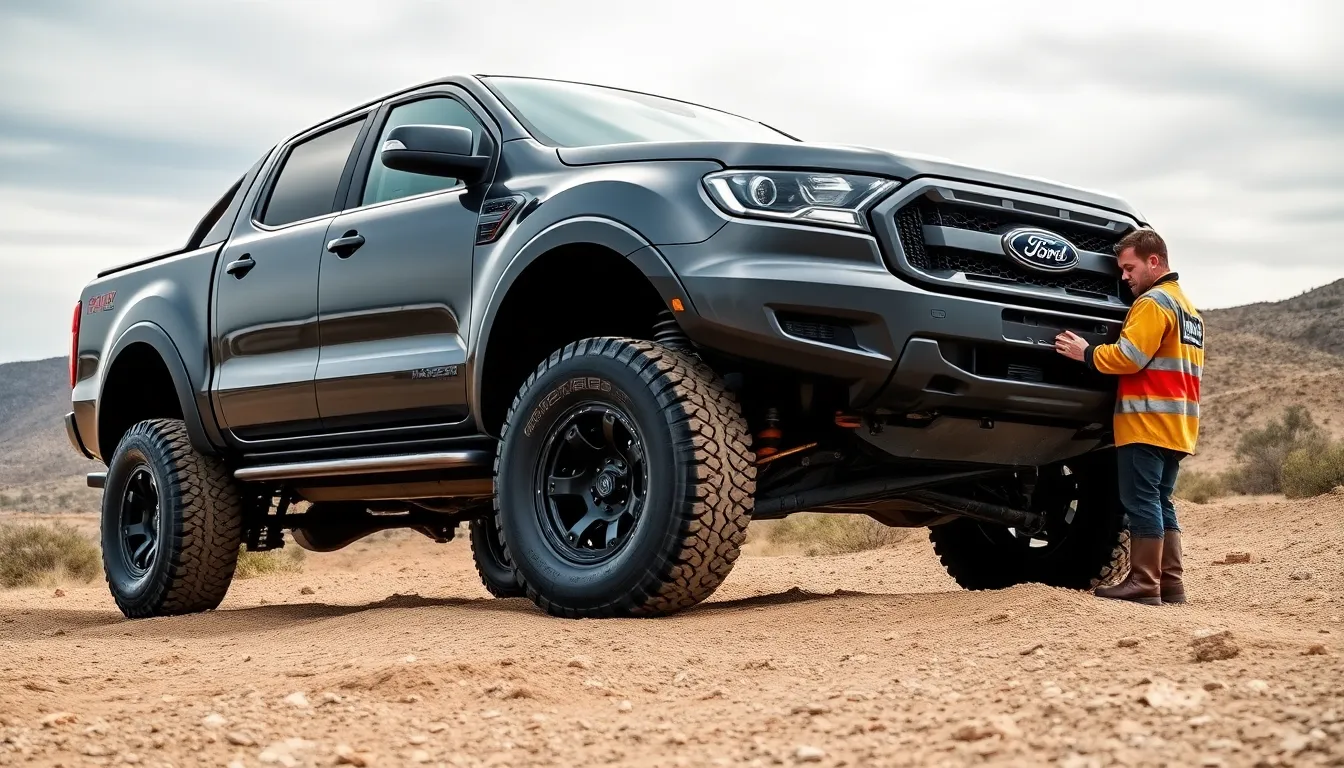
Transmission and drivetrain modifications unlock your Ford Ranger’s true potential beyond what engine upgrades alone can achieve. These enhancements work together with previous modifications to create a cohesive performance package that transforms how power reaches the ground.
Manual vs Automatic Transmission Modifications
Manual transmission upgrades focus primarily on clutch systems and gear ratios to handle increased power output. Performance clutch kits from companies like Centerforce and ACT can handle up to 400 foot-pounds of torque while maintaining smooth engagement for daily driving. Heavy duty pressure plates paired with organic or ceramic disc materials provide the grip needed for modified Rangers without creating harsh engagement characteristics.
Automatic transmission modifications require a different approach centered around valve bodies and torque converters. Shift kits like those from TransGo improve shift firmness and reduce shift overlap that causes power loss and heat buildup. Torque converter upgrades with higher stall speeds between 2,200 and 2,800 RPM allow engines to reach peak torque bands more effectively. Transmission coolers become essential when pushing automatic units harder, with external coolers reducing operating temperatures by 40 to 60 degrees Fahrenheit.
Differential and Gear Ratio Changes
Differential upgrades transform how your modified Ranger distributes power to the wheels during various driving conditions. Limited slip differentials from Ford Racing or Auburn Gear provide traction advantages over open differentials by transferring power to the wheel with better grip. Locking differentials take this concept further, mechanically connecting both wheels for maximum traction in extreme off road situations.
Gear ratio changes affect acceleration, top speed, and fuel economy based on your driving priorities and tire size modifications. Lower numerical ratios like 3.55:1 favor highway cruising and fuel economy with larger diameter tires. Higher ratios such as 4.10:1 or 4.56:1 improve acceleration and low end torque multiplication, especially beneficial with aggressive tire combinations that increase overall diameter. Ring and pinion gear sets from companies like Ford Racing and Motive Gear provide precise ratios matched to your exact build requirements.
4WD System Enhancements
Transfer case modifications improve four wheel drive engagement and durability for Rangers equipped with 4WD systems. Chain drive transfer cases benefit from heavy duty chains that resist stretching under high torque loads. Upgraded shift forks and synchronizers reduce grinding during gear changes while improving engagement reliability in harsh conditions.
Electronic actuator upgrades replace vacuum operated systems that can fail due to leaks or component wear. Electric shift motors provide more reliable engagement and faster switching between 2WD and 4WD modes. Some aftermarket systems add dash mounted controls that give drivers precise command over transfer case operation without relying on factory automatic systems.
Driveshaft upgrades become necessary when combining transmission modifications with differential changes and increased power output. Steel driveshafts replace aluminum units in high performance applications, while upgraded universal joints from companies like Spicer handle increased torque loads. CV joint upgrades improve durability in Rangers with suspension lifts that create steeper driveline angles during articulation.
Essential Safety and Legal Considerations for Modified Ford Rangers

Modifying your Ford Ranger brings exciting performance benefits but requires careful attention to safety and legal requirements. We’ll guide you through the critical compliance areas that keep your modified Ranger street legal while protecting your investment.
State Inspection Requirements
Vehicle inspection standards vary significantly across different states, with some regions maintaining strict modification guidelines while others offer more flexibility. California’s emissions testing requires all engine modifications to carry CARB (California Air Resources Board) certification numbers, while states like Texas focus primarily on safety equipment functionality during annual inspections.
Suspension modifications face height restrictions in most jurisdictions, typically limiting total vehicle height increases to 2-4 inches above manufacturer specifications. Our lifted Rangers must maintain proper headlight aim angles and bumper height compliance to pass state inspections, with many states requiring headlights to remain between 24-54 inches from ground level.
Lighting modifications require DOT approved components for inspection compliance, meaning aftermarket LED light bars and auxiliary lighting systems need proper mounting locations that don’t interfere with required lighting visibility. We’ve found that keeping modification documentation organized helps streamline the inspection process when officials need verification of compliant components.
Exhaust system modifications must meet noise ordinances established by local municipalities, with most areas limiting sound levels to 95 decibels measured at 20 feet from the vehicle. Our performance exhaust upgrades should include removable baffles or adjustable valves to ensure compliance during testing periods.
Insurance Coverage for Modified Vehicles
Standard auto insurance policies often exclude coverage for aftermarket modifications, leaving owners financially vulnerable when accidents involve modified Ford Rangers. We recommend declaring all modifications to insurance carriers during policy updates, providing detailed lists of installed components with corresponding receipts and professional installation documentation.
Agreed value policies protect heavily modified vehicles better than standard replacement cost coverage, especially when modification investments exceed the truck’s original purchase price. These policies require professional appraisals that document all aftermarket components, their installation quality, and current market values for similar builds.
Performance modifications can increase premium costs by 10-25% depending on the insurer’s risk assessment algorithms, though some carriers offer specialized coverage for modified vehicles at competitive rates. We’ve discovered that working with agents familiar with modified vehicle insurance helps secure appropriate coverage without excessive premium increases.
Documentation proves modification legitimacy to insurance adjusters during claim processing, making organized records of receipts, installation photos, and professional work essential for coverage protection. Our modification files should include before and after photos, component serial numbers, and installer certifications to support insurance claims.
DOT Compliance for Street Legal Modifications
Federal Motor Vehicle Safety Standards govern equipment requirements for street legal vehicles, including lighting placement, mirror positioning, and safety equipment functionality that modified Rangers must maintain. We need to ensure our modifications don’t interfere with required safety systems like airbags, seatbelts, or electronic stability control.
Tire and wheel combinations must meet load ratings specified by the vehicle manufacturer, with aftermarket wheels requiring proper load index ratings that match or exceed original equipment specifications. Our oversized tire installations need door placard updates reflecting new tire pressures and load capacities for DOT compliance.
Bumper modifications require impact compliance when significantly altering height or structure, though most bolt-on aftermarket bumpers designed for exact Ford Ranger model years maintain necessary safety standards. We should verify that custom fabricated bumpers don’t compromise airbag deployment zones or create pedestrian safety hazards.
Lighting systems need proper beam patterns and positioning to meet federal requirements, with auxiliary lighting requiring covered lenses or disconnect switches for street driving. Our LED headlight conversions must produce DOT compliant beam patterns without creating glare hazards for oncoming traffic or excessive light scatter.
Conclusion
We’ve explored the extensive industry of Ford Ranger modifications and it’s clear that this versatile platform offers endless possibilities for customization. From performance enhancements that unlock hidden power to suspension upgrades that transform your truck’s off-road capabilities the Ranger proves itself as an ideal canvas for personal expression.
The key to successful modification lies in understanding how each component works together to create a cohesive build. Whether you’re focused on utility improvements like bed modifications or seeking the thrill of drivetrain upgrades every change should align with your exact needs and driving goals.
Remember that proper documentation and compliance with safety regulations protect both your investment and ensure your modified Ranger remains road-legal. With careful planning and attention to detail your Ford Ranger can become the perfect reflection of your style while maintaining the reliability Ford is known for.
Frequently Asked Questions
What makes the Ford Ranger a good choice for modifications?
The Ford Ranger offers exceptional versatility with its robust platform and customization potential. It strikes an ideal balance between affordability and capability, making it accessible to modification enthusiasts. The truck’s reliable Ford engineering provides a solid foundation for various upgrades, from performance enhancements to aesthetic improvements, allowing owners to create a personalized vehicle that reflects their style and needs.
What are the most effective engine modifications for daily driving?
The most impactful engine modifications for daily use include cold air intake systems, performance exhaust upgrades, and ECU tuning. These modifications work together to unlock hidden power while maintaining reliability and drivability. Cold air intakes improve airflow, performance exhausts enhance engine breathing, and ECU tuning optimizes the engine’s parameters to maximize the benefits of other modifications.
Should I choose a body lift or suspension lift for my Ranger?
The choice depends on your intended use. Body lifts are more affordable and provide tire clearance while maintaining the original ride quality, making them ideal for mild off-roading. Suspension lifts offer better ground clearance, improved approach angles, and enhanced off-road capability but cost more and may affect on-road handling. Consider your budget and primary usage when deciding.
What tire type is best for modified Rangers?
All-terrain tires offer the best versatility for most modified Rangers, providing good performance on both pavement and light off-road conditions. They’re ideal for daily drivers who occasionally venture off-road. Mud-terrain tires excel in severe off-road conditions but sacrifice on-road comfort and fuel economy. Choose based on your primary driving conditions and performance priorities.
Do I need special insurance for my modified Ford Ranger?
Yes, modified vehicles often require specialized insurance coverage. Standard policies may not fully cover aftermarket modifications. Consider agreed value coverage that accounts for your modifications’ worth. Document all upgrades with receipts and photos, and discuss your modifications with your insurance provider to ensure adequate coverage and avoid claim disputes.
What legal considerations should I know about modifying my Ranger?
Modified vehicles must comply with state inspection requirements and federal safety standards. Key considerations include emissions compliance, suspension height restrictions, and lighting regulations. Requirements vary by state, so check local laws before modifying. Maintain documentation for all modifications and ensure they meet Department of Transportation (DOT) standards to avoid legal issues and inspection failures.


